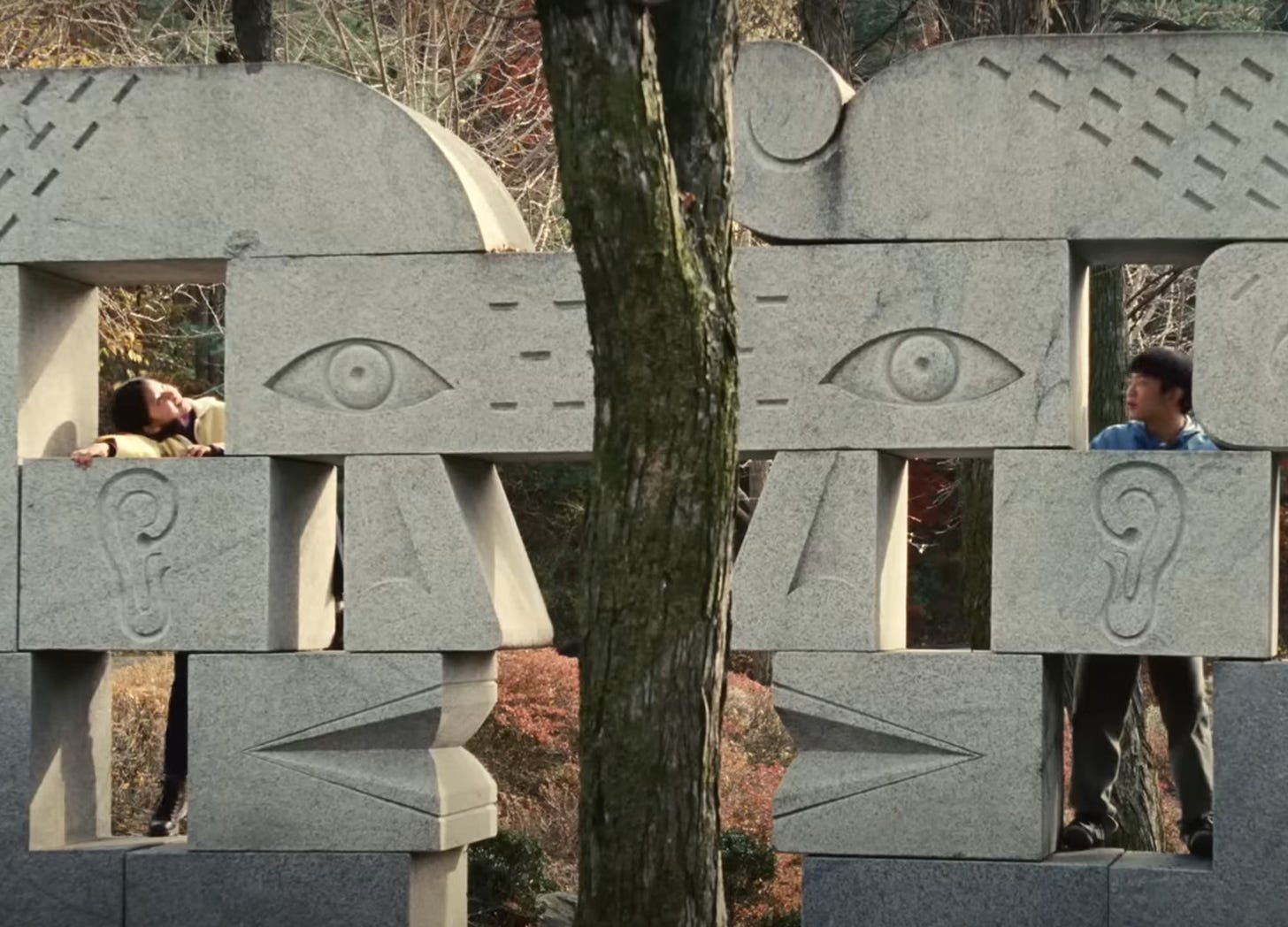History of a Memory
Maybe storytelling isn't a metaphor but an interface: Past Lives and Blade Runner 2049.

A Keepsake for the Journey
In Celine Song’s Past Lives, a mother sets up a playdate for her daughter, Nora, because the family is about to emigrate. The mother is a children’s book illustrator who wants Nora to have “good memories” of her best friend. The phrase — so modest, so practical — sounds like a mother making sure there’s a snack packed for the journey. Yet she’s trying to slip a keepsake into her child’s story, something that will outlast the leaving.
Crossing genres, in Denis Villeneuve’s Blade Runner 2049, the same gesture turns up again, though in a stranger key. Ana, a memory designer for replicants, tells K: “I can’t help your future, but I can give you good memories to think back on and smile.” Two women in different centuries, one with watercolor pencils and one with code, trying to gift someone resilience. You might call it survival, but it’s really something quieter: the ability to keep your bearings.
Twelve Seconds of Now
William James, with his pocket watch and hashish experiments, would have understood. He argued that the present isn’t a knife-edge, a millisecond already dissolving into the past. He called it the specious present: a stretch of time, maybe twelve seconds long, where past and future braid together into now. A saddle-back, he said, wide enough for us to notice change. It feels to me the present never holds still; it slips its own leash. What we call “now” is already half memory; it’s imperfect, but that’s what makes it feel real.
That is the saddle where Ana and Nora’s mother both go to work. They don’t just make art; they plant experiences in the seam where present and past are stitched together. A child’s outing. A replicant’s daydream. Both a little unreal, and both potentially decisive.
When the Horse Catches in the Code
K is the proof. He lives by code — literally. His baseline tests are meant to catch any flicker of deviation. Then one memory catches him instead: a small wooden horse, hidden from a gang of boys. The toy horse lodges in his baseline, snagging code that was meant to be seamless. Replicants are given memories so they will seem more human to humans, not so they will change themselves. But this memory changes K, and it’s testament that a flaw can open into possibility.
“Someone lived this,” Ana tells him. “This happened.”
For K, who has accepted false memories as the only ones he will ever have, this is seismic. The memory feels real, and it is real. Suddenly he can trust his own feelings, an intelligent advantage he was never meant to have. From there rebellion feels almost inevitable. He demands meaning, and in the very demand becomes someone he chooses to be. Our AI-baited culture likes to ask if this makes him human. Perhaps the sharper question is whether it makes him a child.
Children are replicas of a kind. They inherit not just DNA but traditions, reputations, illnesses, challenges. Some inherit property; some fight not to become it. Families ask them to carry burdens, preserve a way of life, finish ambitions left incomplete. None of this is their choosing. Like K, they carry memories arranged for them in advance. No wonder his struggle looks so familiar.
The Bed as Replica
Song makes this visible in her own way. Nora and Arthur, her husband, are posed in bed like Lennon and Ono in that famous Leibovitz photograph. The tableau is perfect, almost too perfect. Like Lennon, Arthur clings naked; but Nora is distracted, and talks about fast food. She replies in English to Arthur’s words in Korean, dropping the connection he offers in the language he learned for her. The replica carries echoes of estrangement. Even intimacy, Song suggests, is a borrowed pose.
And then — the shimmer of Skype. In 2006 it was miraculous to beam a face across oceans, though the pixels were clumsy and the signal faltered. Years after leaving Korea, Nora finds Hae Sung again, not in person but through that laptop connection, bounced through space, faltering even as it carries. When his face flickers onto her screen, he seems to bring her younger self with him. In him she sees the “good memories” her mother planted, glitching and alive in the pixelated haze. James’s saddle is no metaphor here but an interface: the present arriving already nostalgic.
Do We Emerge, or Begin Again?
In James’s saddle of now, Nora is as close to Hae Sung as K is to that wooden horse. And yet, as real as the horse is, as real as the memory feels, neither belongs to him.
Ana says we misunderstand memory: we think it’s about detail, but we remember with feelings — and what’s most human about feelings is their imperfection. They are unreliable narrators at best. Looking at Hae Sung, Nora says,
“That little girl did exist. She’s not here in front of you, but it doesn’t mean she’s not real.”
What she’s telling him is: that’s not me. It seems to me the recognition startles her as much as it does him. The little girl belongs to neither of them.
It is always a shock to realize we are not who we remember ourselves to have been. We bend, we change, but rarely into the shapes we once thought were ours. And yet we remain recognizably ourselves. This is the paradox both Nora and K discover. Identity is continuous even when its contents shift. Do both, in that letting go, emerge more themselves — or simply enter another story?
Memories, however unreliable, are powerful agents. What matters is not their precision but their authenticity. They startle us to life again and again, even as we are still working out who we are.


